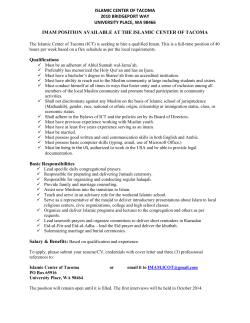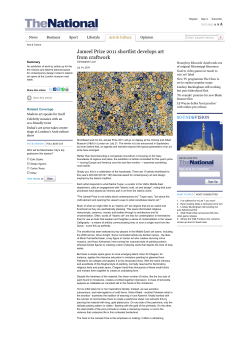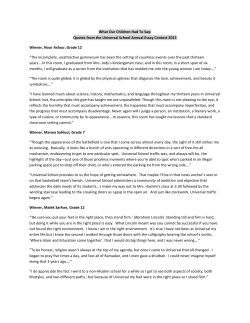
SOLID WASTE AND ITS MANAGEMENT Made by Sahrish (BS Hons in Environmental Science)
SOLID WASTE AND ITS MANAGEMENT Made by Sahrish (BS Hons in Environmental Science) International Islamic University, Islamabad WASTE It is defined as: Waste (also known as rubbish, trash, refuse, garbage, junk) is any unwanted or useless materials. OR “Any materials unused and rejected as worthless or unwanted” and “A useless or profitless activity; using or expending or consuming thoughtlessly or carelessly” Made by Sahrish (BS Hons in Environmental Science) International Islamic University, Islamabad Made by Sahrish (BS Hons in Environmental Science) International Islamic University, INTRODUCTION Since the beginning, Human kind has been generating waste. It could be in the form of: Bones Other parts of animals they slaughter Wood With the progress of civilization the waste generated became of a more complex nature. Made by Sahrish (BS Hons in Environmental Science) International Islamic University, the end of 19th century (Industrial revolution) there was rise in the world of consumers. The increase in population and urbanization was also largely responsible for the increase in solid waste At Made by Sahrish (BS Hons in Environmental Science) International Islamic University, TYPES OF WASTE Solid Waste Liquid Waste Gaseous Wastes Animal by-products Biodegradable waste Biomedical waste Bulky waste Business waste Made by Sahrish (BS Hons in Environmental Science) International Islamic University, Chemical waste Clinical waste Coffee wastewater Commercial waste Construction and demolition waste (C&D waste) Controlled waste Consumable waste Composite Made by Sahrish (BS Hons in Environmental Science) International Islamic University, SOLID WASTE It is defined as: “Non-liquid, non-soluble materials ranging from municipal garbage to industrial wastes that contain complex and sometimes hazardous substances” Made by Sahrish (BS Hons in Environmental Science) International Islamic University, Solid wastes also include: • Sewage sludge • Agricultural refuse • Demolition wastes • Mining residues Made by Sahrish (BS Hons in Environmental Science) International Islamic University, TYPES OF SOLID WASTE Broadly there are 3 types of waste which are as follows: 1. Household waste is generally classified as Municipal waste 2. Industrial waste as Hazardous waste 3. Biomedical waste or Hospital waste as Infectious waste Made by Sahrish (BS Hons in Environmental Science) International Islamic University, MUNICIPAL SOLID WASTE Municipal solid waste consists of: Household waste Construction and demolition debris Sanitation residue Waste from streets. Made by Sahrish (BS Hons in Environmental Science) International Islamic University, Made by Sahrish (BS Hons in Environmental Science) International Islamic University, With rising urbanization and change in lifestyle and food habits, the amount of municipal solid waste has been increasing rapidly and its composition changing. The existing landfills are neither well equipped or well managed and are not lined properly to protect against contamination of soil and groundwater. Made by Sahrish (BS Hons in Environmental Science) International Islamic University, The type of litter we generate and the approximate time it takes to degenerate Type of litter Approximate time it takes to degenerate the litter Organic waste such as vegetable and fruit peels, leftover foodstuff, etc A week or two. Paper 10–30 days Cotton cloth 2–5 months Wood 10–15 years Woolen items 1 year Tin, aluminum, and other metal items such as cans 100–500 years Plastic bags one million years Made by Sahrish (BS Hons in Environmental Science) International Islamic University, HAZARDOUS WASTE Industrial and hospital waste is considered hazardous as they may contain toxic substances. Hazardous wastes could be highly toxic to humans, animals, and plants. They are Corrosive Highly inflammable, or explosive React when exposed to certain things e.g. gases Made by Sahrish (BS Hons in Environmental Science) International Islamic University, Household wastes that can be categorized as hazardous waste include: old batteries shoe polish paint tins old medicines medicine bottles. Made by Sahrish (BS Hons in Environmental Science) International Islamic University, Hospital waste contaminated by chemicals used in hospitals is considered hazardous. These chemicals include formaldehyde and phenols, which are used as disinfectants. Made by Sahrish (BS Hons in Environmental Science) International Islamic University, In the industrial sector, the major generators of hazardous waste are the metal, chemical, paper, pesticide, dye, refining, and rubber goods industries. Direct exposure to chemicals in hazardous waste such as mercury and cyanide can be fatal. Made by Sahrish (BS Hons in Environmental Science) International Islamic University, HOSPITAL WASTE Hospital waste is generated during the diagnosis, treatment, or immunization of human beings or animals It may include wastes like Sharps Soiled waste Disposables Anatomical waste Cultures Discarded medicines Chemical wastes Made by Sahrish (BS Hons in Environmental Science) International Islamic University, These are in the form of disposable syringes, swabs, bandages, body fluids, human excreta, etc. This waste is highly infectious and can be a serious threat to human health if not managed in a scientific and discriminate manner It has been roughly estimated that of the 4 kg of waste generated in a hospital at least 1 kg would be infected Made by Sahrish (BS Hons in Environmental Science) International Islamic University, SOURCES AND OTHER TYPES OF WASTE Source 1:Residential Typical Waste Generators Single and dwellings multifamily Types of solid wastes Food wastes Paper Cardboard Plastics Textiles Leather Yard wastes Wood Glass Metals Ashes Special wastes (e.g bulky items, consumer electronics, white goods, batteries, oil, tires), and Made by Sahrish (BS Hons in Environmental Science) International Islamic University, household hazardous wastes.) 2: Industrial 3:Commercial 4: Institutional Housekeeping wastes Packaging Light and heavy Food wastes manufacturing, fabrication, Construction and construction sites, power and demolition materials chemical plants. Hazardous wastes Ashes Special wastes. Paper cardboard Stores, hotels, restaurants, plastics markets, office buildings, etc. wood food wastes glass metals special wastes hazardous wastes Schools, hospitals, prisons, Same as commercial. government centers. Made by Sahrish (BS Hons in Environmental Science) International Islamic University, 5:Construction and demolition 6:Municipal services 7:Process (manufacturing etc.) 8:Agriculture Wood New construction sites, road steel repair, renovation sites, concrete demolition of buildings dirt etc. Street sweepings Street cleaning, landscaping, landscape and tree parks, beaches, other trimmings recreational areas, water and General wastes from parks wastewater treatment plants. Beaches Recreational areas; sludge. Industrial process wastes Heavy and light manufacturing, Scrap materials refineries, chemical plants, Off-specification products. power plants, mineral extraction and processing. Spoiled food wastes Agricultural wastes Crops, orchards, vineyards, Made by Sahrish (BS Hons in Environmental Hazardous wastes dairies, feedlots, farms. Science) International Islamic University, (e.g., CAUSES OF SOLID WASTE The main sources for solid wastes are domestic, commercial, industrial, municipal, and agricultural wastes. The composition of a city waste is as follows: Paper, wood, cardboard 53 % Garbage 22 % Ceramics, glass, crockery 10 % Metals 8 % Rubber, plastics, discarded textiles 7 % Made by Sahrish (BS Hons in Environmental Science) International Islamic University, Percentages Composition of City Waste 60% 50% 40% 30% 20% 10% 0% Series1 Paper, w ood, cardboard Garbage Ceramic, glass crokery metals Type of Wastes Made by Sahrish (BS Hons in Environmental Science) International Islamic University, Rubber, plastics, discarded textiles The increase in the quantity of solid waste is due to Overpopulation, Affluence (material comfort) Technological advancement Made by Sahrish (BS Hons in Environmental Science) International Islamic University, EFFECTS OF SOLID WASTE a) Health Hazard If solid wastes are not collected and allowed to accumulate, they may create unsanitary conditions. This may lead to epidemic outbreaks. Many diseases like cholera, diarrhea, dysentery, plague, jaundice, or gastro-intestinal diseases may spread and cause loss of human lives. In addition, improper handling of the solid wastes is a health hazard for the workers who come in direct contact with the waste Made by Sahrish (BS Hons in Environmental Science) International Islamic University, b) Environmental Impact If the solid wastes are not treated properly, decomposition and putrefaction (decay) may take place. The organic solid waste during decomposition may generate obnoxious (intolerable) odors. Made by Sahrish (BS Hons in Environmental Science) International Islamic University, WASTE MANAGEMENT 4 R’s CONCEPT Four Rs (Refuse, Reuse, Recycle and Reduce) to be followed for waste management. Made by Sahrish (BS Hons in Environmental Science) International Islamic University, REFUSE Instead of buying new containers from the market, use the ones that are in the house. Refuse to buy new items though you may think they are prettier than the ones you already have. Made by Sahrish (BS Hons in Environmental Science) International Islamic University, REUSE Do not throw away the soft drink cans or the bottles; cover them with homemade paper or paint on them and use them as pencil stands or small vases. Made by Sahrish (BS Hons in Environmental Science) International Islamic University, RECYCLE Use shopping bags made of cloth or jute, which can be used over and over again. Made by Sahrish (BS Hons in Environmental Science) International Islamic University, Made by Sahrish (BS Hons in Environmental Science) International Islamic University, Made by Sahrish (BS Hons in Environmental Science) International Islamic University, REDUCE Reduce the generation of unnecessary waste, e.g. carry your own shopping bag when you go to the market and put all your purchases directly into it. Made by Sahrish (BS Hons in Environmental Science) International Islamic University, Made by Sahrish (BS Hons in Environmental Science) International Islamic University, CONTROL MEASURES The main purpose of solid waste management is to minimize the adverse effects on the environment. The steps involved are: Collection of solid wastes Disposal of solid wastes Utilization of wastes Made by Sahrish (BS Hons in Environmental Science) International Islamic University, COLLECTION OF SOLID WASTES Collection of waste includes gathering the waste, transporting it to a centralized location, and then moving it to the site of disposal. The collected waste is then separated into Hazardous Non-hazardous materials. Made by Sahrish (BS Hons in Environmental Science) International Islamic University, DISPOSAL OF SOLID WASTES Before the final disposal of the solid wastes, it is processed to recover the usable resources and to improve the efficiency of the solid waste disposal system. The main processing technologies are compaction Incineration Manual separation. Made by Sahrish (BS Hons in Environmental Science) International Islamic University, The appropriate solid waste disposal method has to be selected, keeping in view the following objectives: 1. Should be economically viable 2. Should not create a health hazard 3. Should not cause adverse environmental effects 4. Should not result in unpleasant sight, odor, and noise Made by Sahrish (BS Hons in Environmental Science) International Islamic University, UTILIZATION OF WASTES The solid wastes can be properly utilized to gather the benefits such as: Conservation of natural resources Economic development Generate many useful products Employment opportunities Control of air pollution Made by Sahrish (BS Hons in Environmental Science) International Islamic University, SOLID WASTE MANAGEMENT Waste management is the collection, transport, processing, recycling or disposal, and monitoring of waste materials. The term usually relates to materials produced by human activity, and is generally undertaken to reduce their effect on health, the environment or aesthetics. Management is also carried out to recover resources from it. Waste management can involve solid, liquid, gaseous or radioactive substances Made by Sahrish (BS Hons in Environmental Science) International Islamic University, Waste management practices differ for developed and developing nations, for urban and rural areas, and for residential and industrial producers. Management for non-hazardous waste residential and institutional waste in metropolitan areas is usually the responsibility of local government authorities. Management for non-hazardous commercial and industrial waste is usually the responsibility of the generator. Made by Sahrish (BS Hons in Environmental Science) International Islamic University, METHODS OF DISPOSAL Disposing of waste in a landfill involves burying the waste, and this remains a common practice in most countries. Landfills were often established in Abandoned or unused quarries, Mining voids Borrow pits Made by Sahrish (BS Hons in Environmental Science) International Islamic University, A properly designed and well-managed landfill can be a hygienic and relatively inexpensive method of disposing of waste materials Made by Sahrish (BS Hons in Environmental Science) International Islamic University, INCENERATION Incineration is a disposal method in which solid organic wastes are subjected to combustion so as to convert them into residue and gaseous products. This process reduces the volumes of solid waste to 20 to 30 percent of the original volume. Incineration and other high temperature waste treatment systems are sometimes described as "thermal treatment". Made by Sahrish (BS Hons in Environmental Science) International Islamic University, RECYCLING Recycling refers to the collection and reuse of waste materials such as empty beverage containers. The materials from which the items are made can be reprocessed into new products. Material for recycling may be collected separately from general waste using dedicated bins and collection vehicles, or sorted directly from mixed waste streams. Made by Sahrish (BS Hons in Environmental Science) International Islamic University, The most common consumer products recycled include: Aluminum such as beverage cans Copper such as wire Steel food and aerosol cans Old steel furnishings or equipment Polyethylene and PET bottles Glass bottles and jars Paperboard cartons Newspapers, magazines and light paper Corrugated fiberboard boxes. Made by Sahrish (BS Hons in Environmental Science) International Islamic University, SUSTANIBILTY The management of waste is a key component in a business ability to maintaining ISO 14001 official approval. Companies are encouraged to improve their environmental efficiencies each year. One way to do this is by improving a company’s waste management with a new recycling service. (such as recycling: glass, food waste, paper and cardboard, plastic bottles etc.) Made by Sahrish (BS Hons in Environmental Science) International Islamic University, BIOLOGICAL PROCESSING Waste materials that are organic in nature, such as plant material food scraps paper products Can be recycled using biological composting and digestion processes to decompose the organic matter Made by Sahrish (BS Hons in Environmental Science) International Islamic University, The resulting organic material is then recycled as mulch or compost for agricultural or landscaping purposes. In addition, waste gas from the process (such as methane) can be captured and used for generating electricity and heat (CHP/cogeneration) maximizing efficiencies Made by Sahrish (BS Hons in Environmental Science) International Islamic University, ENERGY RECOVERY The energy content of waste products can be harnessed directly by using them as a Direct combustion fuel Indirectly by processing them into another Type of fuel There are 2 types of Thermal Treatment Pyrolysis Gasification Made by Sahrish (BS Hons in Environmental Science) International Islamic University, AVOIDANCE AND REDUCTION METHOD An important method of waste management is the prevention of waste material being created, also known as waste reduction. Methods of avoidance includes: Reuse of second-hand products Repairing broken items instead of buying new Made by Sahrish (BS Hons in Environmental Science) International Islamic University, Designing products to be refillable or reusable (such as cotton instead of plastic shopping bags) Encouraging consumers to avoid using disposable products (such as disposable cutlery) Removing any food/liquid remains from cans Packaging Designing products that use less material to achieve the same purpose (for example, light weighting of beverage cans). Made by Sahrish (BS Hons in Environmental Science) International Islamic University, WASTE HANDLING AND TRANSPORT Waste collection methods vary widely among different countries and regions. Domestic waste collection services are often provided by local government authorities, or by private companies in the industry. Made by Sahrish (BS Hons in Environmental Science) International Islamic University, TECHNOLOGIES The waste management industry has been slow to adopt new technologies such as: RFID (Radio Frequency Identification) tags, GPS Integrated software packages Made by Sahrish (BS Hons in Environmental Science) International Islamic University, WASTE MANAGEMENT CONCEPT There are a number of concepts about waste management which vary in their usage between countries or regions. Made by Sahrish (BS Hons in Environmental Science) International Islamic University, Waste hierarchy The waste hierarchy refers to the "3 Rs" reduce, reuse and recycle, which classify waste management strategies according to their desirability in terms of waste minimization. Made by Sahrish (BS Hons in Environmental Science) International Islamic University, Polluter pays principle - the Polluter Pays Principle is a principle where the polluting party pays for the impact caused to the environment. With respect to waste management, this generally refers to the requirement for a waste generator to pay for appropriate disposal of the waste. Made by Sahrish (BS Hons in Environmental Science) International Islamic University, EDUCATION AND AWARENESS Education and awareness in the area of waste and waste management is increasingly important from a global perspective of resource management. The Talloires Declaration is a declaration for sustainability concerned about the unprecedented scale and speed of environmental pollution and degradation, and the depletion of natural resources. Local, regional, and global air pollution; accumulation and distribution of toxic wastes; destruction and depletion of forests, soil, and water; depletion of the ozone layer and emission of "green house" gases threaten the survival of humans and thousands of other living species. Made by Sahrish (BS Hons in Environmental Science) International Islamic University, SOLID WASTE MANAGEMENT IN PAKISTAN Solid waste collection by government owned and operated services in Pakistan's cities currently averages only 50 percent of waste quantities generated; however, for cities to be relatively clean, at least 75 percent of these quantities should be collected. Unfortunately, none of the cities in Pakistan has a proper solid waste management system right from collection of solid waste up to its proper disposal. Made by Sahrish (BS Hons in Environmental Science) International Islamic University, URBANIZATION PATTERN According to the 1981 census, of the 5.92 million persons who had migrated within the country, 87.6% moved from rural to urban areas, while only 12.4% moved in the opposite direction. Over 50% of them permanently settled in cities. During the last several decades, migration has occurred from rural to urban areas. The chief factors responsible for this migration are: Slow progress in the agriculture sector, Low crop yields, Made by Sahrish (BS Hons in Environmental Science) International Islamic University, Lack of alternate employment opportunities Environmental degradation due to water logging/salinity, deforestation and desertification According to a study, the selected cities are growing at a growth rate from 3.67% to 7.42% which is much higher than the overall growth rate of Pakistan, i.e. 2.8%. Major cities in Pakistan are estimated to double their population in next ten years. These cities are generating high amounts of solid waste which is increasing annually with the respective population growth. Made by Sahrish (BS Hons in Environmental Science) International Islamic University, GROWTH IN SOLID WASTE GENERATION Presently it is estimated that, 54,888 tons per day of solid waste is generated in Pakistan. The Ministry of Environment undertook a study during 1996 on "Data Collection for Preparation of National Study on Privatization of Solid Waste Management in Eight Selected Cities of Pakistan". The study revealed that the rate of waste generation on average from all type of municipal controlled areas varies from 0.283 kg/capita/day to 0.613 kg/capita/day or from 1.896 kg/house/day to 4.29 kg/house/day in all the selected cities. Made by Sahrish (BS Hons in Environmental Science) International Islamic University, SOLID WASTE MANAGEMENT SCENARIO STRATEGIC CHALLENGES Solid waste in Pakistan is generally composed of Plastic and rubber Metal Paper and cardboard Textile waste Glass Food waste Animal waste Leaves Made by Sahrish (BS Hons in Environmental Science) International Islamic University, Grass Straws and fodder Bones Wood Stones and fines to various extents. Made by Sahrish (BS Hons in Environmental Science) International Islamic University, INSTITUTIONAL, LEGAL AND MANAGEMENT ASPECTS Under the recently devolved local government system, the Town/ Tehsil Municipal Administration (TMAs) are responsible for the solid waste collection, transportation and disposal. However, TMAs are unable to cope with continuously increasing volumes of municipal waste due to inadequate funds, lack of rules, regulations and standards, lack of knowhow on the subject, lack of expertise and lack of collection vehicles and equipment Made by Sahrish (BS Hons in Environmental Science) International Islamic University, SOLID WASTE MANAGEMENT POLICY The Government of Pakistan enacted the Pakistan Environmental Protection Act (PEPA) in 1997 which is the most recent and updated legislation on environment. It provides a framework for establishing federal and provincial Environmental Protection Agencies (EPAs). Presently the legal rules and regulations dealing with solid waste management in Pakistan are as follows: Made by Sahrish (BS Hons in Environmental Science) International Islamic University, Current 1: Section 11 of the Pakistan Environmental Protection Act prohibits discharge of waste in an amount or concentration that violates the National Environmental Quality Standards. 2: Draft Hazardous Substances Rules of 1999. 3: Islamabad Capital Territory Bye Laws, 1968 by Capital Development Authority Islamabad 4: Section 132 of the Cantonment Act 1924 deals with Deposits and disposal of rubbish etc 5: Provisions contained in the Local Government Ordinance, 2001 Made by Sahrish (BS Hons in Environmental Science) International Islamic University, Required The rules and guidelines that are yet to be introduced include: Basic Recycling rules Waste Management rules E-Waste Management rules Development of Environmental Performance Indicators (EPI) Eco-Labeling guidelines and its promotion Adoption of Life Cycle Assessment Approaches Guidelines for Environmentally Sound Collection and Disposal Guidelines for model landfill sites Made by Sahrish (BS Hons in Environmental Science) International Islamic University, CURRENT STATUS OF SWM PRACTICES Currently solid waste in Pakistan has not been carried out in a sufficient and proper manner in Collection Transportation Disposal or dumping regardless of the size of the city. These aspect may include: Made by Sahrish (BS Hons in Environmental Science) International Islamic University, Rate of urbanization Pattern and density of urban areas Physical planning and control of development Physical composition of waste Density of waste Temperature and precipitation Scavenger’s activity for recyclable separation The capacity Adequacy and limitations of respective municipalities to manage the solid waste. Made by Sahrish (BS Hons in Environmental Science) International Islamic University, According to the 1998 census, of the 130.579 million persons living in Pakistan, 67% live in rural areas, while 33 % live in urban areas. Furthermore, out of 33 % of persons living urban areas, 54 % of them live in ten major cities of Pakistan. During the last several decades, migration has occurred from rural to urban areas. The major factors responsible for this migration are: Slow progress in the agriculture sector Low crop yields Lack of alternate employment opportunities Environmental degradation due to water logging/salinity Deforestation and desertification. Made by Sahrish (BS Hons in Environmental Science) International Islamic University, POPULATION AND HOUSEHOLD ESTIMATES The number and growth of population and households is the foremost factor affecting the solid waste and its management at various stages. The selected cities are growing at a rate ranging between 3.67% to 7.42%, which is much higher than the overall growth rate of Pakistan, i.e. 2.8% (EPMC, 1996). Made by Sahrish (BS Hons in Environmental Science) International Islamic University, Major cities of them are estimated to double their population in next ten years. The numbers of households also play an important role in generation and collection of the solid waste. The average household size in the selected cities varies from 6.7 to 7.3 persons. Made by Sahrish (BS Hons in Environmental Science) International Islamic University, WASTE GENERATION AND COLLECTION ESTIMATES The average rate of waste generation from all type of municipal controlled areas varies from 1.896 kg/house/day to 4.29 kg/house/day in a few major cities. It shows a trend of waste generation wherein increase has been recorded in accordance with city's population besides its social and economic development. Made by Sahrish (BS Hons in Environmental Science) International Islamic University, In Pakistan, solid waste is mainly collected by municipalities and waste collection efficiencies range from 0 percent in low-income rural areas to 90 percent in high- income areas of large cities. Collection rate of solid waste by respective municipalities ranges from 51% to 69% of the total waste generated within their jurisdiction. Made by Sahrish (BS Hons in Environmental Science) International Islamic University, PHYSICAL COMPOSITION OF WASTE The move from landfill-based to resource-based waste management systems requires a greater knowledge of the composition of municipal solid waste. Solid waste in Pakistan is generally composed of three categories i.e. Biodegradable such as food waste, animal waste, leaves, grass, straws, and wood. Non-biodegradable are plastic, rubber, textile waste, metals, fines, stones and Recyclable material includes paper, card board, rags and bones. Made by Sahrish (BS Hons in Environmental Science) International Islamic University, WASTE TREATMENT AND DISPOSAL The waste is disposed off within or outside municipal limits into low lying areas like ponds etc, without any treatment except recyclable separation by scavengers. The land is also hired/leased on long term basis for disposal. Moreover, the least mitigating measures have also never been reported from any municipality. Treatment and disposal technologies such as sanitary land filling, composting and incineration are comparatively new in Pakistan Made by Sahrish (BS Hons in Environmental Science) International Islamic University, Crude open dumping is the most common practice throughout Pakistan and dump sites are commonly set to fire to reduce the volume of accumulating waste. At present, there are no landfill regulations or standards that provide a basis for compliance and monitoring, but national guidelines for these standards are being prepared by the Consultant under National Environmental Action Plan Support Program (NEAP SP). Made by Sahrish (BS Hons in Environmental Science) International Islamic University, CONCLUSION The overall conclusion of the study on present status of solid waste management in Pakistan as follows: 1.There is a limited focus on control mechanisms which is adversely effecting on safety, health and the environment. 2.Regulations are inadequately enforced and SWM does not seem to be a priority. 3.None of the cities has an integrated solid waste management system Made by Sahrish (BS Hons in Environmental Science) International Islamic University, Collection rate 5 1-69 % of total waste generated. Hospital and industrial wastes are treated as ordinary waste A lot of potential for recycling and involvement of private sector which is overlooked No disposal facilities Made by Sahrish (BS Hons in Environmental Science) International Islamic University, Open burning of waste or open disposal is most common practice. No weighing facilities are installed at any disposal sites Open burning of non-degradable components like plastic bags are adding to air pollution Much of the uncollected waste poses serious health hazards Made by Sahrish (BS Hons in Environmental Science) International Islamic University, RECOMMENDATIONS Following recommendations are proposed for sustainable SWM: 1.The involvement of people and private sector through NGOs could improve the efficiency of SWM. 2.Public awareness should be created especially at primary school. 3.Littering of SW should be prohibited in cities, towns and urban areas. 4.Moreover, house-to-house collection of SW should be organized Made by Sahrish (BS Hons in Environmental Science) International Islamic University, The collection bins must have a large enough capacity to accommodate 20% more than the expected waste generation in the area. Municipal authorities should maintain the storage facilities to avoid unhygienic and unsanitary conditions. Proper segregation would lead to better options and opportunities for scientific disposal of waste. Made by Sahrish (BS Hons in Environmental Science) International Islamic University, An open dump or an uncontrolled waste disposal area should be rehabilitated. It is advisable to move from open dumping to sanitary land filling in a phased manner. Land filling should be restricted to non-biodegradable, inert waste and other waste that are not suitable either for recycling or for biological processing Made by Sahrish (BS Hons in Environmental Science) International Islamic University, Made by Sahrish (BS Hons in Environmental Science) International Islamic University,
© Copyright 2025









